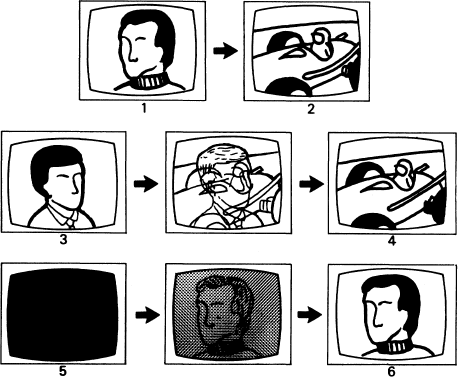Vision Mixer: General Facilities
The sophisticated switcher offers all the visual effects (and more!) to the TV director that are available in the film-making process. Effects that require time, skill, and costly auxiliary equipment in film, can be achieved in TV at the touch of a button.
The cut
Even the simplest mixer can cut between picture sources. The cut is an instantaneous switch from one picture to another. As with all types of transition, there must be no frame-roll or flash evident on the picture at the moment of cutting.
The mix or dissolve
Here the transition is less pronounced. As the faders are operated the established picture (e.g. Camera 2) fades away, while the new picture (e.g. telecine) progressively appears. Both picture sources appear on the screen simultaneously. Obviously the speed of the mix is dictated by the production requirement. A mix can take several seconds or can be almost instantaneous.
The fade-up/fade-out
As the fader is operated a picture can be made to either appear from or disappear into a black screen. Two ways of achieving this effect are common: (1) a mix or dissolve from a picture to black level set up on the normal mix/ effects panel of the mixer; (2) if a master fader is incorporated at the output of the mixer, operating this fader produces a dissolve from or to black.
The superimposition
By fading up two or more picture sources together, we obtain a superimposition. This device may be used to add titling to an existing picture, or special montage effects.
Preview facilities
Certain mixers have a separate preview bank (preview bus), with the video output connected to an associated monitor. This enables us to check any selected non-studio picture source (e.g. a remote) before switching it to the transmission channel. It assists, too, in preparing a combination picture (of two or more cameras’ shots).
As it is operated, the vision mixing desk also switches corresponding cue lights (tally lights) on the cameras to denote which is ‘on air’ (for camera operators, floor manager, artistes, etc.).
Practice varies as to who operates the vision mixing desk. It may be a specialist operator (the switcher or vision mixer) or the technical director; in small studios and in outside broadcast units the director may operate the vision mixing panel.

An instantaneous change, achieved by pressing the cut-button of the second channel, e.g. From Cam 1 (1) To Telecine (2).
The cut is used when action in the two scenes is consecutive.
The mix
The first picture (3) fades in intensity, the second simultaneously strengthening to full intensity (4). (Holding the controls midway produces superimpositions.) Achieved by fading between the banks, different sources having been selected on their respective banks (e.g. Cam 2 on Bank A to Telecine on Bank B). The mix usually signifies a lapse of time.
Fade up
The screen is black (5), the picture gradually strengthens to full intensity (6). The required channel is selected on one bank, but the associated half of the dual fader is faded out (split fader). As the fader is operated, the picture appears. Moving the control to ‘out’, the picture fades away.
